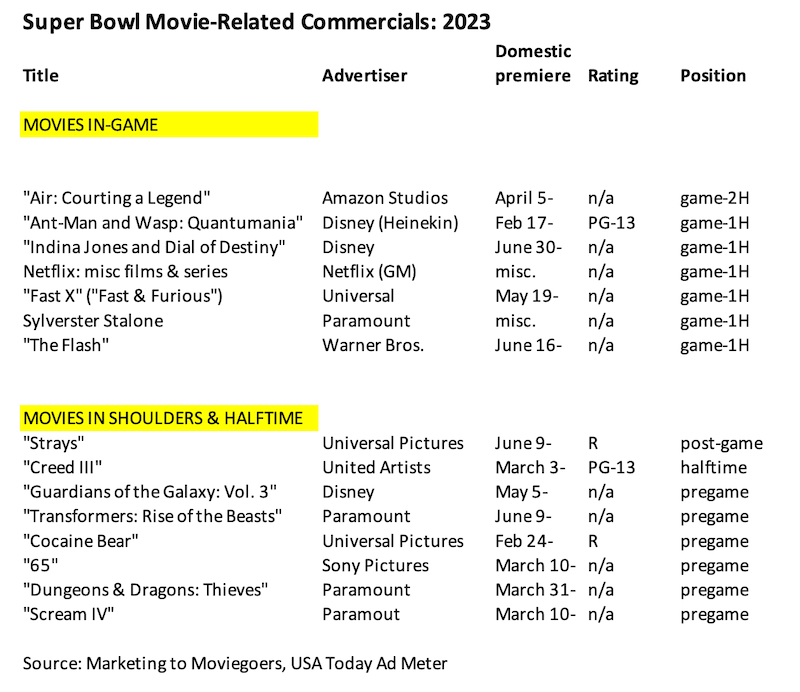Theatrical film distributors were a force with seven in-game commercials out of 51 in the Super Bowl football game, according to USA Today Ad Meter, returning after a pandemic withdrawal. Hollywood movie spots were also heavy in Super Bowl adjacencies with another eight commercials in the pregame, halftime and postgame.
A normal range is four to eight theatrical films in-game (while in 2021 there was just one due to cinema closures from Covid). This year’s in-game spots cost between $6 million and $7 million for U.S. TV’s biggest audience of about 113 million viewers (remember such advertising buys involve multiple spots at once so it’s not clear what any one commercial is priced).
The seven commercials in the peak in-game include Amazon Studios for “Air: Courting a Legend”; Walt Disney Studios with “Ant-Man and the Wasp: Quantumania” (co-presented with Heineken’s beer); Netflix (with General Motors electric vehicles) for movies/TV series; Walt Disney Studios again with “Indiana Jones”; Universal Pictures for “Fast X” (the “Fast and Furious” franchise); Paramount+ for a brand-sell built around movie-star Sylvester Stallone; and Warner Bros. for superhero “The Flash.”
The other eight movie ads appeared off-peak periods (pregame, halftime and postgame). They are Walt Disney Pictures for “Guardians of Galaxy: Vol. 3”; Paramount Pictures with “Transformers: Rise of the Beast”; Universal Pictures for animated “Strays”; United Artists Releasing with “Creed III” (continuing the “Rocky” saga); Universal Pictures again for “Cocaine Bear”; Sony Pictures for its out-of-this-world sci-fi “65”; “Paramount Pictures for live-action “Dungeons & Dragons: Honor Among Thieves”; and finally Paramount again for horror “Scream VI.”
In watching the game, “Guardians of the Galaxy” and “Transformers” commercials seemed in-game at the kick-off start, but other researchers did not log them in-game, including USA Ad Meter.
Some observations: I was surprised that Disney co-branded its commercial for theatrical “Ant-Man and The Wasp: Quantumania” with Heineken beer; the comic book adaptation movie is rated PG-13, which is below the age for drinking alcohol. Also, there was the aforementioned carmaker GM teaming with Netflix. The list of seven in-game movie ads includes Netflix and Paramount+ for somewhat generic movie messaging; that’s a function of video streamers pitching a subscription instead of a cinema ticket which is a one-time purchase.

Another observation is that movie commercials tend to rank low in postgame lists of most popular advertising most years simply because spots simply aggregate scenes from the movie. Other products/services create pricey, original advertising that are more eye-catching (who could forget the gerbils shot from a cannon into a wall in a 2011 blurb from a dot-comer?). But remember that movie scenes can be effective in selling, which is the prime goal, not to be talked-about outrageous (and quickly forgotten).
This year in-game movie ads were bunched mostly above the half-way mark for 51 blurbs ranked by USA Today’s Ad Meter, which is a better-than-normal rankings.
In a normal year, there are 60 in-game commercials or even more. But this year some commercials longer than the standard 30-seconds, which ate up time. For instance in the movie category, the Netflix/General Motors commercial and Universal Pictures “Fast X” commercials were both for 60 seconds. Walt Disney Co. placed a 90-second commercial dubbed “Disney100 Special Look” that is a corporate sell tied to the company’s 100th anniversary (for this analysis, the jumbo “Disney100” commercial is not counted as a movie advertisement; it was historical in scope and not promoting a new release).
There were about a dozen entertainment related commercials in game and in adjacencies too, which were not movies. For example, the newly-built Las Vegas Sphere arena promoted a U2 music residency in a 15-second, in-game commercial and there was that jumbo “Disney100” commercial.
One of the co-branded entertainment ads is for streamer Peacock TV series “Poker Face,” with M&M candies (not on the accompanying log lists because this is a TV series, not a one-shot movie). The candy maker likely paid for all or most of the commercial.
The parent of game telecaster Fox Broadcasting bailed out of the theatrical film business in 2019 so none of the theatrical film commercials came from Fox corporate siblings (though there were a lot of TV program promos). In past Super Bowls when advertising sales were slow, host TV broadcasters would tap their movie distribution corporate siblings to buy commercials at the last minute for a sellout; there’s no such movie sibling safety-net option for Fox.
As a trend of the past decade, the Super Bowl was loaded with non-film entertainment commercials and also Hollywood celebrities in commercials for consumer goods.
The entertainment media ads not directly tied to movies include spots for Disney’s general brand on the company’s 100th anniversary and the Las Vegas Sphere for residency of rock band U2. Celebrities appearing in consumer goods ads include Steve Martin and Ben Stiller (for Pepsi), Bradley Cooper (T-Mobile cell phone), Kevin Hart (DraftKings betting), and the list goes on and on.
Milestones in Super Bowl Commercial History
- 2022: Netflix takes center stage buying three 60-second commercials for its “Movie Preview and the Adam Project” campaign.
- 2021: Aggressive video streamers offset loss of theatrical film commercials due to pandemic.
- 2020: An average count of five theatrical movie commercials are telecast, but films get delayed or go direct-to-video streamers with later theater closures due to pandemic.
- 2010: In what is a normal slate, eight theatrical films get commercials including “Cowboys and Aliens” (which would bomb) and car-actioner “Fast Five” (soon a blockbuster!)
- 1996: Hollywood embraces after the money-shot of the White House obliterated wows audiences taken from alien-invasion yarn “Independence Day.”
- 1984: Apple computer’s odd-ball “1984” dystopian society TV commercial electrifies audiences and starts a trend of making lavish ads just for event.
- 1978: Average TV viewership soars to 79m persons, versus 27m a decade earlier; today hovers around 100m persons — the biggest audience in TV.
- 1967: The first Super Bowl is a rush-launched, not even selling out the stadium.
Related content:

Leave a Reply